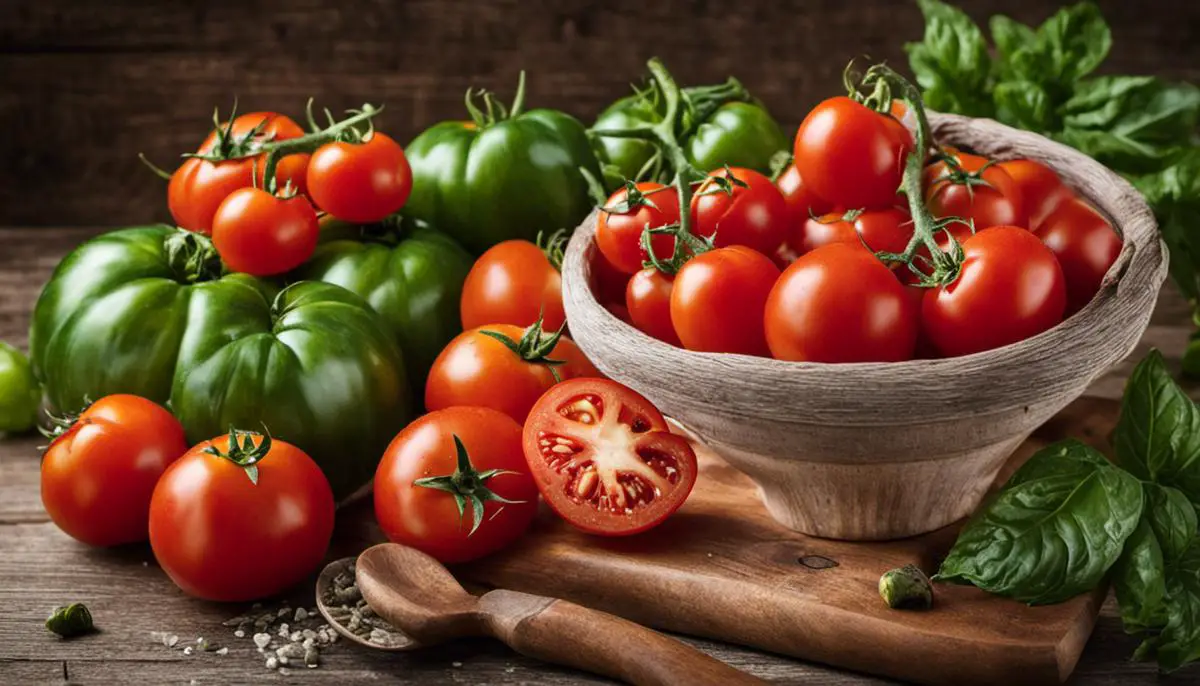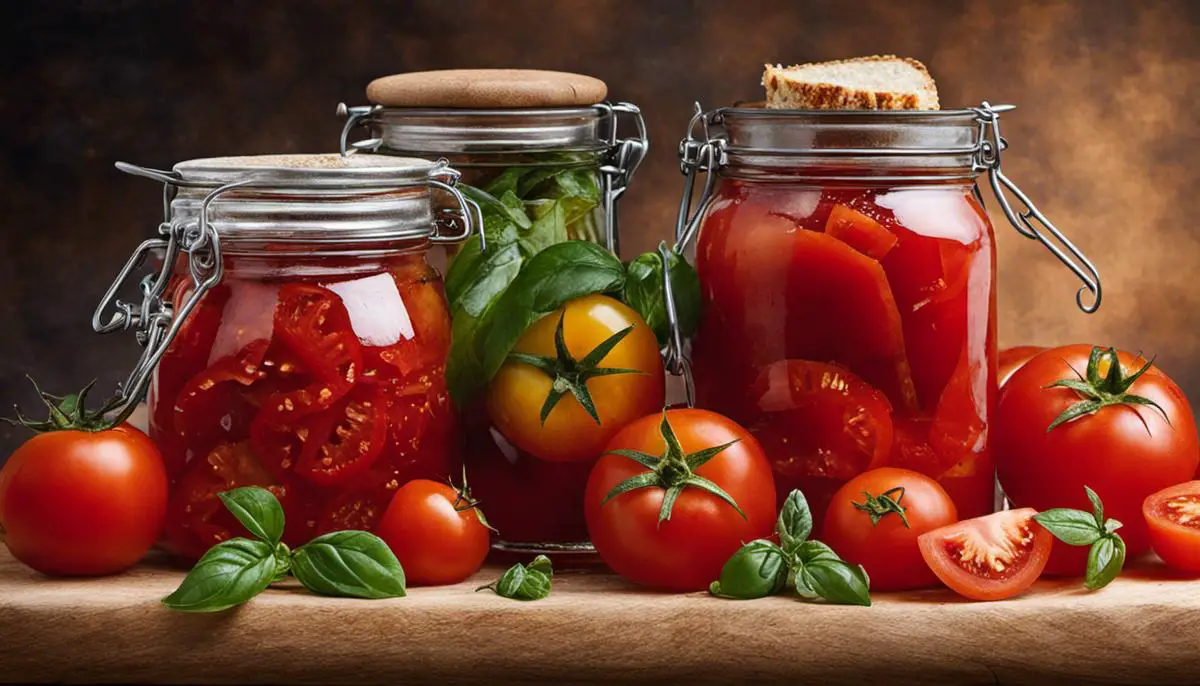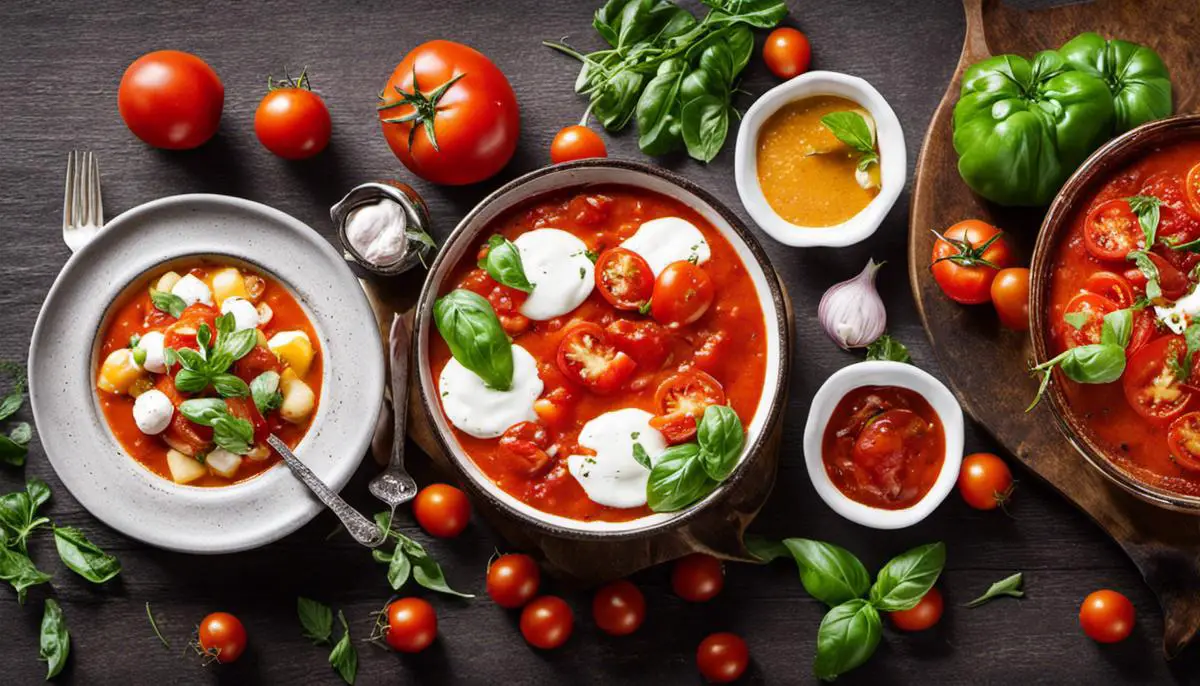Table of Contents
When one thinks of the myriad possibilities in culinary arts, the humble tomato emerges as a versatile and valuable contributor. Bursting with flavor and packed with nutritional benefits, they truly hold a rightful space in kitchens across the globe. This guide will take you on a captivating exploration of tomatoes – their types, uses, and preparation techniques, with an added emphasis on unlocking the nutritional benefits they offer. Simultaneously enriching your understanding of this vibrant fruit, we delve into diverse cooking methods, preparing your palate for a joyful journey of discovering and mastering tomato-centric recipes.
Understanding tomatoes
Understanding Tomatoes
Tomatoes are a versatile ingredient used in countless dishes worldwide. To fully appreciate their potential in cooking, you should familiarize yourself with the various types of tomatoes, each equipped with unique taste profiles, freshness indicators, and best uses.
The most commonly encountered types include Beefsteak, Roma or Plum, Cherry, Grape, and Heirloom tomatoes. Beefsteak tomatoes are large, juicy, and full of flavor, making them perfect for sandwiches or eating raw. Roma or Plum tomatoes, characterized by their elongated shape, are primarily used in sauces, pastes, and canning because of their thicker fruit walls and fewer seeds. Cherry and Grape tomatoes are small, sweet and often used in salads or as garnishes. Meanwhile, Heirloom tomatoes are old-fashioned varieties that come in many shapes, colors, and flavors – they’re best savored raw or in simple dishes to showcase their taste.
When selecting tomatoes, look for ones that have a vibrant, consistent color, are firm to the touch but give a little when pressed, and have a distinct tomato-y aroma. The bottom or the stem end should feel plump, indicating the tomato is fully ripe. Avoid tomatoes that are overly soft, have broken skin or spots, or emit an off smell.
Cooking with Tomatoes
Each type of tomato lends itself to different uses. The big, juicy Beefsteak tomatoes are excellent for slicing and using in sandwiches or burgers. Roma tomatoes, with their minimal seeds and robust flesh, are perfect for creating sauces, pastes, or stews. Smaller tomatoes like Cherry or Grape tomatoes have a sweet flavor that’s ideal for salads, pasta dishes, or roasting whole. Heirloom tomatoes, prized for their unique flavors, are often simply sliced and sprinkled with salt, used in Caprese salads, or layered onto bruschetta.
Nutritional Benefits of Tomatoes
In addition to their culinary uses, tomatoes boast a rich nutritional profile. They are high in vitamin C, potassium, and the antioxidant lycopene, which is linked to many health benefits including reduced risk of heart disease and cancer. Tomatoes also contain folate, vitamin K, and fiber, making them a healthy addition to any dishes. Whether incorporated into a salad, simmered into a hearty sauce, or simply sliced and enjoyed fresh, incorporating more tomatoes into your diet can provide substantial health benefits.

Preparation techniques
Preparing Tomatoes: A How-to Guide
The world of cooking with tomatoes begins with mastering a variety of preparation techniques. Whether you’re making salsa or pasta sauce, or topping a burger, different methods of preparing tomatoes will greatly affect the flavor and texture of your finished dish. The art of dicing, slicing, roasting, blanching, and peeling tomatoes are all techniques that are easily learned.
Dicing Tomatoes
Dicing tomatoes involves cutting them into small, cube-like pieces. Start by slicing off the stem end of the tomato. Then, cut the tomato in half from top to bottom. Lay the halved tomatoes flat side down and make vertical cuts all the way across. Turn the tomato 90 degrees and make another set of vertical cuts. Your tomatoes are now diced, ready for a salad, salsa, or to be sautéed.
Slicing Tomatoes
Slicing tomatoes is perfect for sandwiches or burgers. To do this, cut off the stem end, then simply slice the tomato into even rounds. Keep in mind that using a sharp, serrated knife helps to maintain the integrity of the tomato’s structure while cutting.
Roasting Tomatoes
Roasting tomatoes enhances their natural sweetness and adds a smoky, caramelized flavor. To roast tomatoes, preheat your oven to 425 degrees Fahrenheit. Cut the tomatoes in half, place them cut-side-up on a baking sheet, drizzle with olive oil, and season with salt and pepper. Roast in the oven until the tomatoes are soft and slightly charred, generally around 20-25 minutes. Roasting is perfect for making tomato soup or pasta sauce.
Blanching Tomatoes
The process of blanching tomatoes involves boiling them briefly and then putting them immediately into ice water. This technique is commonly used to easily remove the skins of the tomatoes. To blanch tomatoes, start by making a small ‘x’ with a knife on the bottom of the tomato. Submerge the tomato in boiling water for about 30 seconds, until you see the skin start to wrinkle and peel back. Immediately plunge the tomatoes into ice water to halt the cooking process. The skin should now easily slip off.
Peeling Tomatoes
Peeling tomatoes may sound daunting, but it becomes very simple once the tomato has been blanched. Simply grasp the skin of the blanched tomato and gently pull—it should readily peel away from the fruit. The peeled tomatoes are now ready to be used in sauces, salsas or canning.
In conclusion, the method of preparing tomatoes depends on the recipe and desired texture. Familiarize yourself with these different techniques to make your cooking process with tomatoes an enjoyable and flavorful journey.

Recipes and cooking methods
Classical Tomato Soup Recipe
First, prep your tomatoes by roughly chopping them into quarters and setting them aside. You’ll also want to dice one large onion and mince three cloves of garlic. Melt two tablespoons of butter in a large pot over medium heat. Add your onions and cook until they’re translucent, then add your garlic and stir until you can smell the aroma. Next, add the chopped tomatoes, 4 cups of vegetable broth, a teaspoon of sugar, and your preferred herbs, such as basil or oregano. Let the mixture simmer for 15 minutes. After simmering, use an immersion blender or regular blender to puree the soup to your preferred texture. Season with salt and black pepper to taste.
Sautéed Cherry Tomatoes Method
This simple side dish can complement almost any main course. Start by washing your cherry tomatoes and patting them dry. Heat two tablespoons of olive oil in a pan over medium heat. When the oil shimmers, add your cherry tomatoes without overcrowding the pan. Cook for about 2-3 minutes or until the skin of the tomatoes start to blister. Add two minced garlic cloves and sauté it with the tomatoes until they are fragrant. Season with salt, black pepper and a sprinkle of fresh basil, and serve warm.
Tomato Bruschetta Recipe
Grab a loaf of your favorite crusty bread and slice it into 1-inch thick pieces. Arrange these slices on a baking sheet and drizzle them with olive oil before popping into a 350°F oven for about 10 minutes or until toasted. While these are toasting, combine diced fresh tomatoes, minced garlic, chopped basil, a splash of balsamic vinegar, and a pinch of salt. Once your bread slices have cooled slightly, heap spoonfuls of the tomato mixture on top of the bread.
Slow Cooker Tomato Sauce
For those who love a good tomato sauce but hate the time it takes to make, this slow cooker option is perfect. In your slow cooker, combine a large can of crushed tomatoes, one diced onion, four cloves of garlic, two teaspoons of dried basil, one teaspoon of dried oregano, a pinch of red pepper flakes, half a cup of red wine, and a teaspoon of salt. Stir and let cook on low for 6-8 hours or high for 4-6 hours. After it’s done, you can blend the sauce if you want a smoother texture or leave it chunky.
Tomato and Mozzarella Salad
To create this fresh and tasty salad, slice ripe tomatoes and fresh mozzarella cheese into rounds. Arrange these in an alternating, overlapping pattern on a platter. Drizzle with a balsamic glaze and generously sprinkle with fresh basil leaves. Season with salt and pepper to taste.
These recipes should equip you with a variety of ways to use the range of tomatoes available. Enjoy experimenting with different types and tastes to find your perfect method.

As our journey with tomatoes comes to an end, it leaves us better equipped to make well-informed culinary choices and versatile in our preparation techniques. From understanding the intricate taste profiles of different tomato varieties to exploring the vibrant assortment of dishes that celebrate the humble tomato, we’ve deepened our appreciation for this versatile fruit. And yet, it’s just the beginning. With the nutritional benefits and the cooking methods at your disposal, the culinary world awaits your tomato-infused creations, ready to surprise and satisfy the gastronomic adventurers out there. So go ahead, apply your newfound knowledge, and bask in the experience of cooking with tomatoes.
